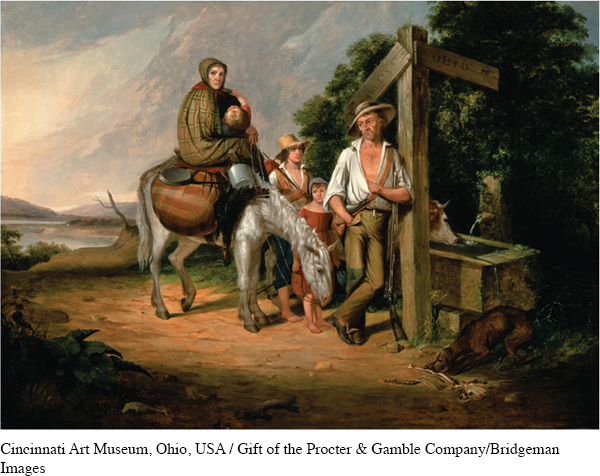White Southerners without Slaves
Yeomen farmers, independent owners of small plots who owned few or no slaves, had a complex relationship with the South’s plantation economy. Many were related to slave owners, and they often depended on planters to ship their crops to market. Some made extra money by hiring themselves out to planters. Yet yeomen farmers also recognized that their economic interests often diverged from those of planters. As growing numbers gained the right to vote in the 1820s and 1830s, they voiced their concerns in county and state legislatures.
Most yeomen farmers believed in slavery, but they sometimes challenged planters’ authority and assumptions. In the Virginia slavery debates, for example, small farmers from western districts advocated gradual abolition. In other states, they advocated more liberal policies toward debtors. Yeomen farmers also questioned certain ideals embraced by elites. Although plantation mistresses considered manual labor beneath them, the wives and daughters of many small farmers worked in the fields, hauled water, and chopped wood. Still, yeomen farmers’ ability to diminish planter control was limited by the continued importance of cotton to the southern economy.
In their daily lives, however, many small farmers depended more on friends and neighbors than on the planter class. Barn raisings, corn shuckings, quilting bees, and other collective endeavors offered them the chance to combine labor with sociability. Church services and church socials also brought communities together.
An even larger number of white Southerners owned no property at all. These poor whites depended on hunting and fishing in frontier areas, performing day labor on farms and plantations, or working on docks or as servants in southern cities. Poor whites competed with free blacks and slaves for employment and often harbored resentments as a result. Yet some, including poor immigrants from Ireland, Wales, and Scotland, built alliances with blacks based on their shared economic plight.

Some poor whites remained in the same community for decades, establishing themselves on the margins of society. They attended church regularly, performed day labor for affluent families, and taught their children to defer to those higher on the social ladder. Other poor whites moved frequently and survived by combining legal and illegal ventures. They might perform day labor while also stealing food from local farmers. These men and women often had few ties to local communities and little religious training or education. Although poor whites unnerved southern elites by flouting the law and sometimes befriending poor blacks, they could not mount any significant challenge to planter control.
The South’s small but growing middle class distanced themselves from poorer whites in pursuit of stability and respectability. They worked as doctors, lawyers, teachers, and shopkeepers and often looked to the North for models to emulate. Many were educated in northern schools and developed ties with their commercial or professional counterparts in that region. They were avid readers of newspapers, religious tracts, and literary periodicals published in the North. And like middle-class Northerners, southern businessmen often depended on their wives’ social and financial skills to succeed.
Nonetheless, middle-class southern men shared many of the social attitudes and political priorities of slave owners. They participated alongside planters in benevolent, literary, and temperance (anti-alcohol) societies and agricultural reform organizations. Most middle-class Southerners also adamantly supported slavery. In fact, some suggested that bound labor might be useful to industry. Despite the emergence of a small middle class, however, the gap between rich and poor continued to expand in the South.
Exploring American HistoriesPrinted Page 324
Exploring American Histories Value EditionPrinted Page 241
Chapter Timeline